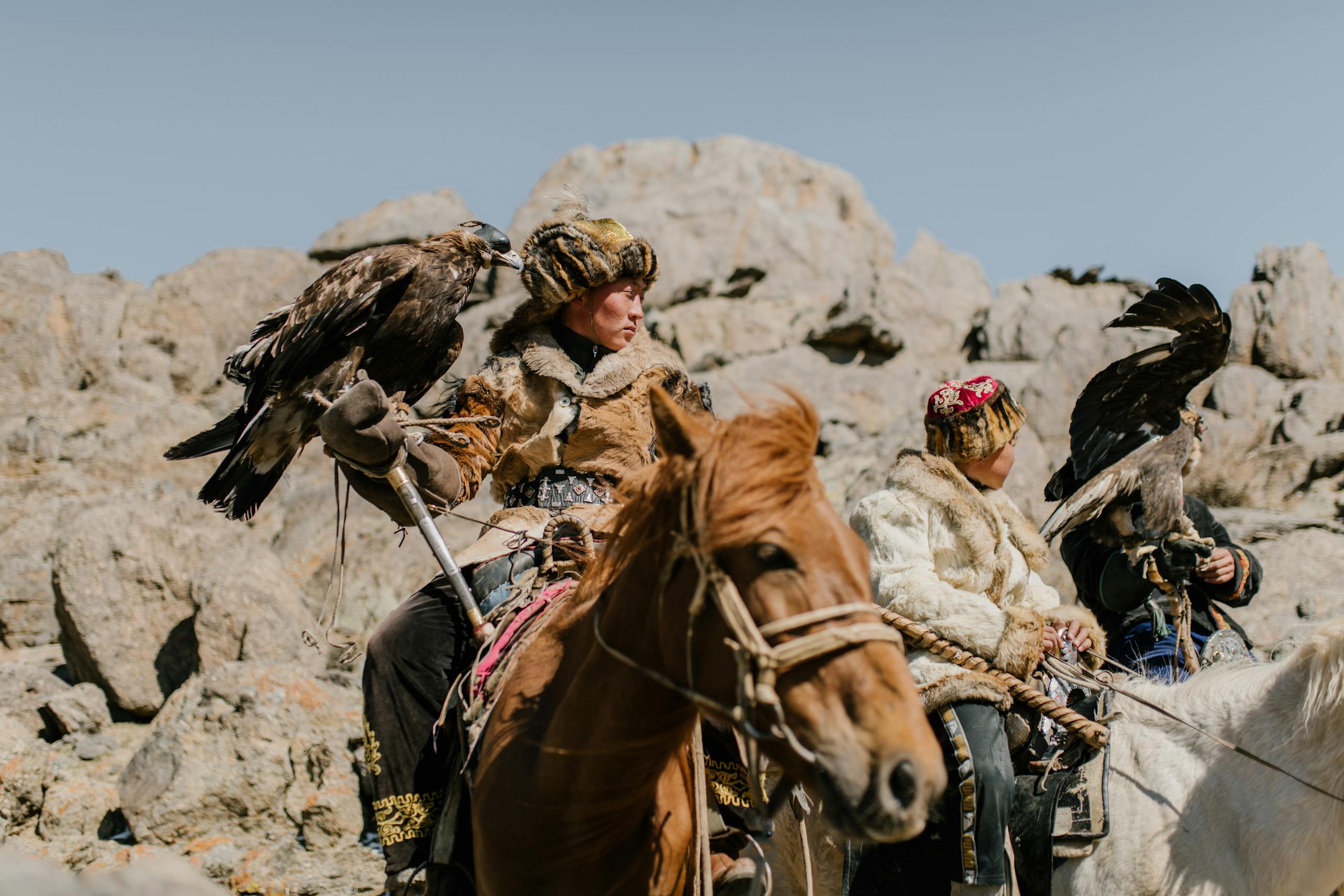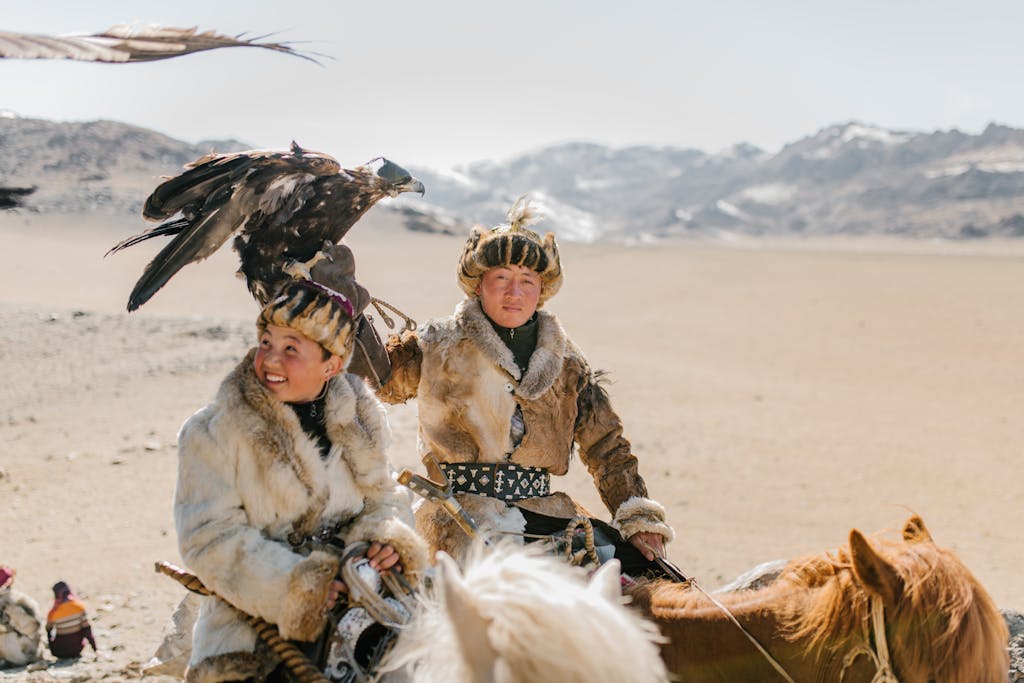Mongolian Eagle Hunting
Mongolian eagle hunting, known as “berkutchi” or “burkitshi,” is a remarkable and ancient form of falconry prevalent in Kazakh and Kyrgyz communities in Mongolia, involving the training of golden eagles to hunt prey like foxes and hares in the harsh terrain of Western Mongolia.
Key Takeaways:
- Ancient Tradition: Passed down through generations, often from father to son.
- Cultural Identity: Deeply embedded in the hunter’s cultural way of life.
- Seasonal Hunting: Typically conducted in colder months when prey’s coats are fullest.
- Profound Relationship: Eaglets are treated with great care and released back into the wild after years of service.

The tradition is passed down through generations, often from father to son, and begins with capturing a young eagle from its nest. The bird is painstakingly trained and becomes a close companion to the hunter. These hunters, clad in traditional heavy coats and fox fur hats, are not just hunting for sport; the practice is deeply embedded in their cultural identity and way of life.
Eagle hunting is typically done during the colder months when visibility is high and the prey’s coats are fullest, which are more valuable. The relationship between the eagle and its handler is profound, with the birds treated with great care and respect.

After many years of service, the eagles are usually released back into the wild, ensuring they can live out the remainder of their lives in their natural habitat.
This form of hunting is also a significant aspect of local festivals and competitions, where hunters display the skills of their eagles, and it contributes to the preservation of their cultural heritage in a rapidly modernizing world.
Venture into the vast landscapes of Mongolia, and you might witness a breathtaking dance between man and nature – the centuries-old tradition of Mongolian Eagle Hunting.
This captivating practice not only showcases the harmonious bond between the eagle and its master but also delves into the intricate art of training these majestic birds.
What is Eagle hunting?
At its core, eagle hunting is a time-honored method of hunting game using trained golden eagles as hunting companions.
This practice has deep roots in Mongolian culture, with its origins tracing back to the nomadic tribes that roamed the sweeping Mongolian steppes.
Today, it stands as a symbol of tradition, skill, and the unbreakable connection between humans and animals.

Golden Eagle Festival
The Eagle Hunting Festival, also known as the Golden Eagle Festival, is a spectacular cultural event held annually in Mongolia, primarily in the Bayan-Ölgii Province which is located in the western part of the country. The festival showcases the ancient tradition of Kazakh eagle hunters, or berkutchi, and their skilled golden eagles.
Key Features of the Festival:
- Timing: The festival typically occurs in early October, taking advantage of the relatively mild weather before the harsh Mongolian winter sets in.
- Events: Participants compete in various tests of their eagles’ speed, accuracy, and agility. One of the main events includes the eagles being released from a ridge to swoop down at high speeds to their handler on horseback.
- Traditional Attire: Both the hunters and their eagles wear traditional garb, which adds to the visual spectacle. The hunters don traditional Kazakh clothing, and the eagles are often fitted with beautiful leather hoods and elaborate decorations.
- Additional Competitions: Besides the eagle competitions, the festival includes horse racing, archery, and the traditional Kazakh game of kokpar (a form of tug-of-war played on horseback with a goat carcass).
- Cultural Significance: It’s a time for local Kazakh communities to gather and celebrate their heritage, including music, dance, and a display of traditional handicrafts.
Cultural Impact:
The Golden Eagle Festival is not only a way to preserve the unique tradition of eagle hunting among the Kazakh people but also serves as an attraction for tourists from around the world. It offers a rare glimpse into the lives and traditions of Mongolia’s Kazakh people and contributes significantly to the local economy through tourism.
The festival highlights the profound bond between the eagle and its master, a relationship built on mutual respect and cooperation that epitomizes the cultural ethos of the Mongolian Kazakhs.
Golden Eagle Festival date
The Golden Eagle Festival usually takes place annually during the first weekend of October. This timing allows participants and spectators to enjoy the event in relatively mild weather conditions before the onset of the harsh Mongolian winter.
The festival typically lasts for two days and is held in Bayan-Ölgii Province, which is in the western part of Mongolia. This schedule makes it an ideal time for tourists to visit and experience this unique cultural showcase alongside the local festivities.



Art of Training:
- Selection Process: Before the training begins, a young eagle is selected based on specific criteria. The trainers look for qualities like strength, courage, and a keen sense of sight.
- Building Trust: Trust is the cornerstone of eagle training. The trainer spends dedicated time bonding with the eagle, fostering a connection based on trust and companionship.
- Basic Commands: Eagles are taught a set of basic commands, including recall and perching on the trainer’s arm. Positive reinforcement, like treats and praise, plays a crucial role in this learning process.
- Hunting Techniques: The trainer introduces the eagle to hunting techniques, guiding it through simulated hunts using lures. This step-by-step process ensures that the eagle becomes a skilled and effective hunting companion.
The Thrill of the Hunt:
Once the training is complete, the eagle and its trainer embark on hunting expeditions across the vast Mongolian landscapes.

The eagle, perched high on the trainer’s arm, scans the surroundings with its piercing gaze. When prey is spotted, the eagle takes flight, executing a graceful and calculated attack.
Preserving a Cultural Treasure:
Beyond the thrill of the hunt, Mongolian eagle hunting is a cultural treasure that deserves preservation.

Efforts are underway to pass down the art of eagle training from generation to generation, ensuring that this mesmerizing tradition remains an integral part of Mongolian heritage.
























